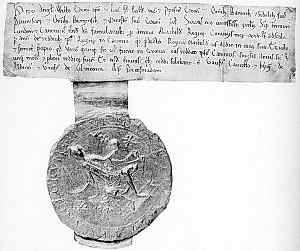 |
|
Anglo-Saxon
Charters and Writs (2) |
|
The
diplomatic
of the vernacular
writ was somewhat
simpler than that of the Latin diploma,
with less elaborate language. Before the Norman Conquest and for some
considerable time afterward they had no written date, while the description
of the nature of the grant was less complex and specific. It was framed
much more particularly as an oral declaration, rather than as a piece
of leftover written documentation from an ancient civilisation, deployed
in a different social environment, like the Latin diploma. The great
seal was its authentication, so that it could be read out without
the presence of the king, but he was still effectively its witness. |
The
format of the document was as follows:
- It
began with the title of the king (eg Eadward cynge).
- It
contained an address. It was not addressed to the beneficiary, but usually
to the bishops, earls and thegns of the shire where rights were to be exercised.
- It
included a greeting (grete ........ freondlice)
- This
was followed by a notification clause, something like let
it be known that in Old English.
- Then
followed the main text of the grant, indicating just what benefits were
being granted in a fairly concise format
- It
finished with various clauses, which could include the farewell God
eow gehealde.
|
|
The
whole format was that of an oral declaration, and it is possible that it was
not originally intended to replace the Latin diploma, but to supplement it
by making the content known in a public arena. However, the increasing numbers
of writs and decreasing numbers of diplomas surviving from the 11th century
suggest that the vernacular writ became accepted as a title deed in its own
right. |
|
And
then ... |
|
|
William
the Conqueror invaded England from Normandy in 1066. Some textbooks put the
beginning of medieval English history at this date, but as you can see, there
was an awful lot going on already. |
|
The
new King William did not bring in fancy Continental forms for his written
instruction and grants. Initially he used the same type of vernacular
writs as his Anglo-Saxon predecessors. From around 1070, they were issued
in Latin, but these were simply a translation into Latin of the Old
English form; a Latinisation of a specifically English style of document.
Eadward cynge became Willelmus
rex anglorum. Grete became salutem.
Let it be known became sciatis or notum sit. The testibus clause was introduced, followed by the names of witnesses. The great seal
of William the Conqueror resembled that of Edward the Confessor on the
obverse side, showing the king in majesty. |
|
|
The
great seal of William the Conqueror. |
|
The
royal charter,
or diploma, or writ, or whatever you want to call it, continued to develop
and diversify. The list of persons addressed became more varied, depending
on the nature of the grant. The place of issue was included late in the
reign of William I and the date was included more commonly during the
12th century. It became a document which was delivered open, rather than
folded with the seal
hanging down, and sometimes the seal was attached by tags rather than
a tongue cut from the main parchment
sheet. |
 |
Charter
or writ of Henry I (British Library, Cotton Charter vii. 2). |
| The example at left is addressed to the bishop of Exeter, the sheriff of Devon and others confirming an annual grant to Holy Trinity, Aldgate, London for the soul of his wife Matilda. There are three witnesses and it was produced at Portsmouth, but there is no written date. The seal is attached with a tag |
|
|
|
These
charters or writs served a dual function, both as title deeds
to land and as an administrative order to a royal officer, normally the
sheriff. The form and function continued to diversify so that by the time
of King John, in the 13th century, there were two basic forms. The solemn
charter addressed to all manner of significant people and surrounded by
all its ceremonious language became the formal title deed. The writ was
a letter to the sheriff, another royal officer or even to a private individual
conveying an order, instruction or prohibition. |
|
Perhaps
the most interesting point to ponder is the evolution of these documents and
their relationship to literate administration in the distant past of the Roman
Empire. There was not a simple route of transmission from literate Rome to
medieval England. Instead, the process was partially reinvented in a society
that did not, in fact, have a fully literate mode of functioning, Anglo-Saxon
England. |
 previous
page previous
page |
 Categories
of Documents Categories
of Documents |
|
 |
 |
 |


